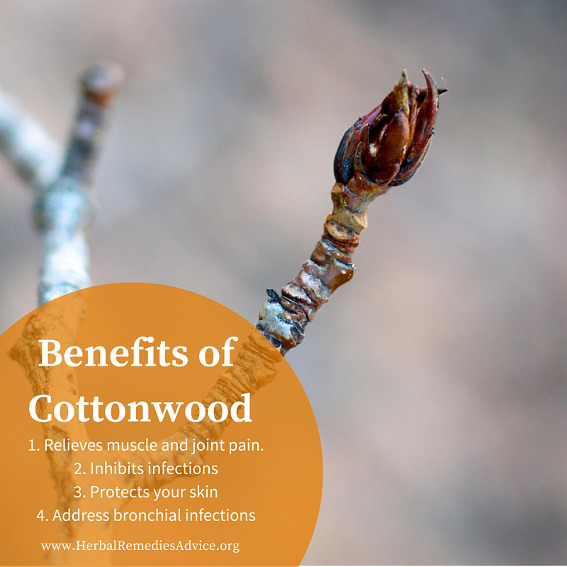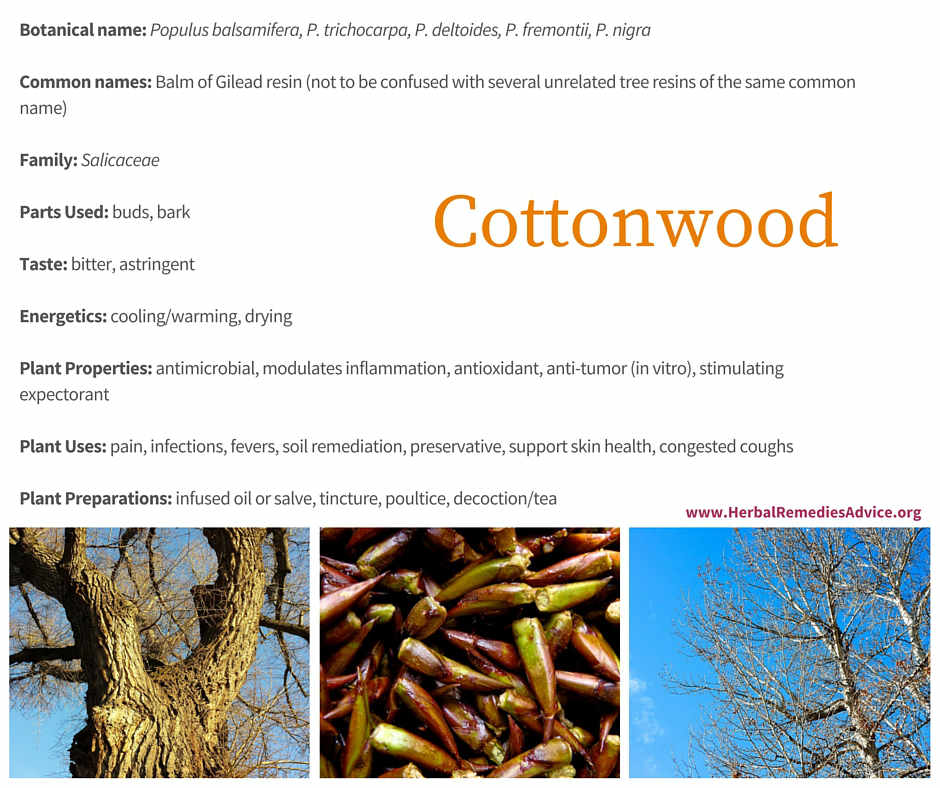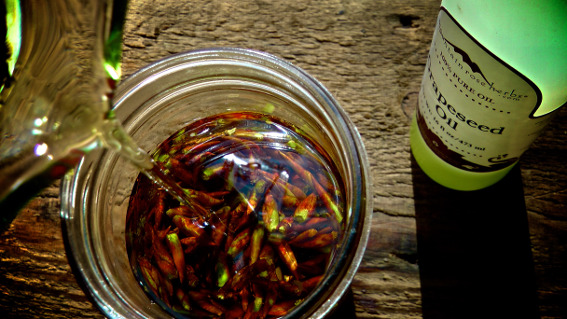Get weekly tips, recipes, and my Herbal Jumpstart e-course! Sign up for free today.

Cottonwood Benefits
Share this! |
|
While many swoon over its amber balsamic scent, the cottonwood tree (Populus spp.) is more than just a pretty smell. For thousands of years, cottonwood has been used as medicine and to make a variety of tools.
I honestly can’t imagine my life without this powerful tree and cottonwood bud oil (also called Balm of Gilead oil), which I use in practically all of my herbal salves, creams, and body butters.
With this episode you’ll also receive FREE access to a downloadable recipe card you can refer to again and again for how to make cottonwood bud oil of your own.
After listening in, you’ll know:
► How to work with cottonwood bud oil medicinally
► How I discovered that cottonwood is an amazing preservative
► The super-cool way researchers studied Poplar trees as a potential treatment for warts… and the intriguing results
► What you need to know to ethically harvest cottonwood
-- TIMESTAMPS --
- 00:00 - Introduction
- 04:55 - Cottonwood (Populus spp.) energetics
- 06:02 - Common ways herbalists use cottonwood today
- 09:12 - Interesting scientific studies about cottonwood
- 13:23 - How to identify cottonwood
- 15:19 - Tips for working with cottonwood
- 18:28 - Safety when working with cottonwood
- 19:09 - Cottonwood bud oil recipe (Balm of Gilead oil)
- 25:05 - Cottonwood herbal tidbit
Download Your Recipe Card!
l
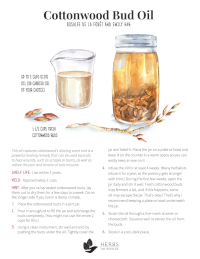
Transcript of the Cottonwood Benefits Video
It’s February here in Washington state, which is the perfect time to harvest cottonwood buds for medicine, especially to infuse those resinous buds into oil. I honestly can’t imagine my life without this powerful tree and cottonwood bud oil, which I use in practically all of my herbal salves, creams and body butters. More on that in just a bit.
Hello and welcome to the Herbs with Rosalee Podcast, a show exploring how herbs heal as medicine, as food and through nature connection. I’m your host, Rosalee de la Forêt. I created this YouTube Channel to share trusted herbal wisdom so that you can get the best results when relying on herbs for your health. I love offering up practical knowledge to help you dive deeper into the world of medicinal plants and seasonal living.
Each episode of the Herbs with Rosalee Podcast is shared on YouTube, as well as your favorite podcast app. Also, to get my best herbal tips as well as fun bonuses, be sure to sign up for my weekly herbal newsletter at the bottom of this page. Okay, grab your cup of tea and let’s dive in.
Today, we’re recording this cottonwood bud video from inside our warm and cozy cabin. Admittedly, I wanted to record this outside with the cottonwood trees hugging the banks of the Methow River, but the snow and the bright sun made recording pretty tricky, definitely beyond our basic camera skills.
We did go to one of my favorite trails, and once we realized recording wasn’t possible, I harvested some branches to bring home. One advantage to recording this inside is that you don’t have to hear my chattering teeth. The day we went out to film, it was 18°F or -7°C. I do love to visit that trail all times of the year because every time we’re there, we see many different signs of life, like kingfishers, river ducks, deer, coyotes, ravens, signs of otters, and very importantly, signs of beavers. In my local habitat, it’s the beavers building homes along the rivers who help me to harvest the cottonwood buds. I’ll share more about that in the harvesting section.
Another cool feature of this trail is the interpretive signs that were created just a few years ago. These signs share more about the cottonwood tree and its relationship to the Methow people, the original inhabitants here, as well as the salmon who depend on the cottonwood to thrive, and many other cottonwood gifts.
Humans have long loved cottonwood. Practically every part of the cottonwood tree has been used whether it was the wood for building, the bark’s fiber or the buds as medicine. My husband prefers cottonwood branches for making friction fires. Today, these water sentinels continue to be cherished for their beauty and their resinous medicine. They form an important part of the ecosystem by cleaning the air and soils, providing habitat for animals and even supplying winter forage for deer. The next time you’re with a cottonwood tree, breathe deep and appreciate all the beauty that this tree has to offer.
Do you have experience with cottonwood? I’d love to hear about it in the comments. Your comments mean a lot to me. I love cultivating a community of kindhearted, plant-loving folks. Plus, it’s always interesting and insightful to hear the experiences of plant lovers out there, and you never know, your suggestion may also help others. And if you love getting quality herbal information you can trust, then I would love to welcome you to my weekly newsletter. Each week, I send out my best herbal tips recipes and insights. I love my newsletters, but you don’t have to take my word for it. Here’s what Cathryn from Corvallis, Oregon had to say:
Dear Rosalee,
Your weekly herb-filled emails are a highlight of my week. Unlike all the other alarmist and sales-oriented messages that flood in, yours brings positive energy and truly useful information that I can and do apply right away. They are timed for the seasons and always seem to provide just the amount of information I was curious about. Thank you for your years of sharing your love of herbs and how to use them.
Okay, let’s dive in.
Cottonwood Benefits: Energetics
Mention cottonwood benefits to a room of herbalists and I bet you’ll find more than a few people swooning.
Sure, someone in the room may be thinking of its potent antimicrobial properties or the way it can magically relieve muscle pain. But most will be dreaming of that memorable heady scent that is unmistakably cottonwood. Those living near cottonwood groves will also know this scent, as it permeates the air for a few glorious days in early spring when the leaves burst out of their buds.
While many swoon over the amber balsamic scent, cottonwood is more than just a pretty smell. For thousands of years, it has been used as medicine and to make a variety of tools. This heavy cottonwood scent comes from the resins within the buds. Cottonwood trees produce these resins to protect the tender new leaves and flowers that will soon be emerging. This resin is antimicrobial and antifungal. Cottonwood bud medicine is warming and dispersive.
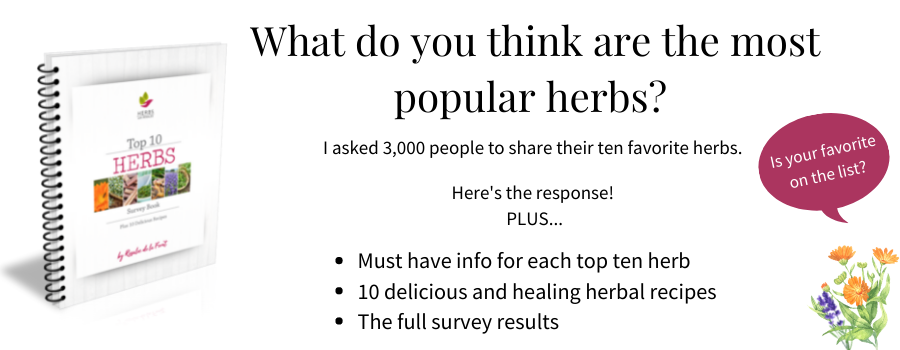
Common Ways Herbalists Use Cottonwood Today
A while ago, I did an informal poll in the American Herbalists Guild Facebook Group, asking which part of the cottonwood tree people use the most often. Of the people responding, all of them use the buds, while a few people said that they also use the bark and the leaves. So, while herbalists are using various parts of the cottonwood, by far, the most commonly worked with part is the buds.
Here are some specific ways that herbalists commonly work with cottonwood buds.
Cottonwood Benefits for Aches and Pain
Cottonwood bud oil can be massaged into sore muscles and joints to relieve many aches and pains such as sore or strained muscles, rheumatic pains and pains from injuries like bruises. Cottonwood buds are high in a variety of constituents that can directly relieve pain, and also, modulate inflammation. I’ll share how to make cottonwood bud oil in just a bit.
Cottonwood Benefits for Infections and Skin Conditions
In addition to modulating inflammation and decreasing pain, cottonwood is also strongly antimicrobial. This makes it a fabulous heal-all type of remedy for topical use on a variety of conditions like wounds, rashes and bug bites. I rarely make an herbal salve that doesn’t have some cottonwood in it because it’s so universally helpful, but there’s also another reason I like to include it...
Cottonwood Benefits as a Preservative
One year, I was cleaning out a box of old salves when I found the very first cottonwood salve I’d ever made. At the time, it was only six years old. Every other salve that was in that box from the same time period had gone rancid, but the cottonwood salve smelled as divine as the day I made it.
I learned two things from this experience. The first, make less salve so you don’t end up throwing the excess away, and secondly, cottonwood is an amazing preservative. Since then I’ve included cottonwood oil or cottonwood tincture into most of my salves and creams.
Cottonwood Benefits for Respiration and Digestion
While I mostly use cottonwood topically, cottonwood is also great as
internal medicine. Herbalist Michael Moore wrote a lot about cottonwood
medicine. He recommended a tincture of the buds as an excellent
expectorant for thick, intractable mucus from bronchitis and
bronchorrhea, as it has both expectorant and aromatics and analgesic
salicylates.1 Moore also recommended the bitter bark as part of an
old-fashioned bitters recipe. He wrote in his book, Medicinal Plants of the Mountain West,
“Make an excellent, old-fashioned bitters by steeping an ounce of the
dried cottonwood bark, one-fourth licorice root, and a teaspoon of
cloves in a fifth of brandy. After a month, the bitters have matured and
can be sipped on for poor appetite, indigestion and feverishness,” and
then, in his typical tongue-in-cheek way, he added, “Though no fault of
the herbs, excess sipping can lead to undesirable side effects.”2
Interesting Scientific Studies about Cottonwood Benefits
There are many scientific studies on various species of cottonwood. While some of these studies confirm traditional uses of cottonwood such as being antimicrobial, they also have shown innovative ways to work with cottonwood for soil remediation to get rid of warts and to decrease aging of the skin.
Here’s a review of some interesting studies on various species of cottonwood:
Cottonwood is Fairly Non-Allergenic
Do you think you’re allergic to cottonwood? It turns out that while many people point to cottonwood as the cause of their seasonal allergies, very few people are actually allergic to it and instead are reacting to grasses that release pollen at the same time.3,4
Cottonwood Benefits for Wart Removal
Poplar trees have been shown to be super effective in removing warts.
In this study, researchers compared two different types of treatments for warts. One group had their warts treated with smoke from burnt leaves of the Populus euphratica tree. The other group had their warts treated with cryotherapy (freezing). Those who received the smoke treatment had better cure rates (66.7% vs. 46.4%) and a dramatically reduced recurrence rate (4.2% vs. 32.2%).5
That's really impressive!
Cottonwood for Soil Remediation
Cottonwood trees help to clean the soils they live in.
Numerous studies have been done to determine various Populus species’ ability to clean contaminated soil as well as to increase CO2 sequestration (reducing excess atmospheric carbon that contributes to climate change). It turns out that, not only does cottonwood remove many contaminates from the soil, it continues to metabolize them into less toxic compounds within the tree.6
Cottonwood Protects Against Skin Aging (in vitro)
Cottonwood can also protect skin health.
I admittedly feel a little weird whenever I share information about the “anti-aging” ability of plants. Our culture tends to worship the young and pity the old with their wrinkles. I don’t subscribe to the forever-young fascination and don’t want to perpetuate it.
The fact remains, however, that the sun can damage the skin and many botanicals can help protect the skin and keep it healthy.
In this study, researchers first showed the phenolic content of the Populus nigra plant, identifying the major antioxidant components. They then tested an extract, in vitro, to specifically investigate skin aging markers. They concluded that, “Among the detected genes, poplar bud extract significantly regulated genes involved in antioxidant defenses, inflammatory response and cell renewal.” They continue with, “[The] effect of this extract suggests potential antiaging properties which could be utilized in cosmetic and nutraceutical formulations.”7
Instead of waiting for a cosmetic formula to be released at your local drug store, I recommend making your own herbal creams and oils with cottonwood. This is something we teach in our online medicine making course, Rooted Medicine Circle.
Anti-Tumor Properties of Cottonwood (in vitro)
There’s been a few in-vitro studies looking at cottonwood’s ability to fight cancer.
For example, a 2022 study showed that Populus nigra had a lot of promising benefits against a breast cancer cell line including showing antiangiogenic potential and immunomodulatory effects.8
In the past couple of years, several different species of Populus have had some interesting in vitro tests in regards to lung cancer.9,10,11 It’s worth mentioning that we can’t assume that in vitro studies will have the same effects in living humans, but this initial type of study may pave the way for more research in this area, possibly even human clinical trials.
Botanically Speaking
Cottonwoods are deciduous trees that are often found growing near water and can easily survive flooding. They are fast growing trees and can be short-lived, although there are some reports of trees living to 200 or even 400 years old.
Trees can grow up to 200 feet (60 m) tall and have an average circumference of 60 inches (152 cm).
The species name for cottonwood, “Populus” derives from Latin, which means people. Historians think this may be because cottonwood trees were often planted around public places.
Common species of cottonwood in N. America include P. nigra, P. deltoides, P. fremontii.
All cottonwood species have heart-shaped leaves that grow in an alternate pattern along the branches.
The older bark is quite wrinkled and of varying shades of grey.
As I’ve just shared, the buds are covered in a sticky resin that is highly antimicrobial, which protects the tree from infection. The buds continue to grow through the winter months and then erupt into catkins and leaves in the beginning of spring. The catkins then grow into green fruits that grow in drupes.
Sometime around May these fruits erupt, creating a “cottonwood snow storm.” The seeds are covered in a white fluff that helps them to travel on the wind for many miles. This is how the tree got its common name of cottonwood.
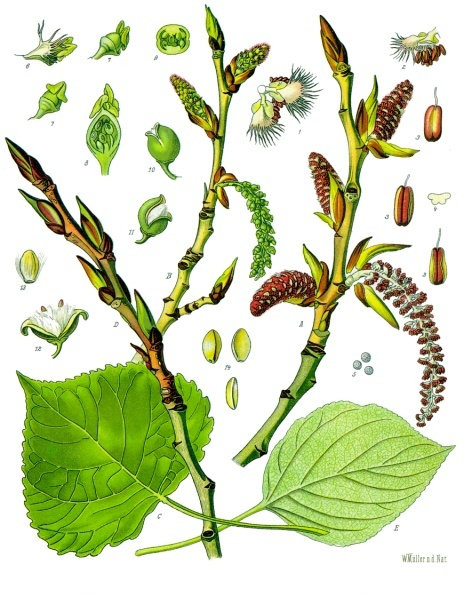 The Botany of Cottonwood
The Botany of CottonwoodHow to Use Cottonwood
Some herbalists forage all the plants they use, whether they are growing the plants themselves or harvesting from the wild. Others may order fresh or dried herbs from herbal farmers or online apothecaries like Mountain Rose Herbs. But because cottonwood buds aren’t easily found in commerce, finding and harvesting them yourself is an herbal right of passage. To locate a Populus tree near you, head to the nearest river, hardwood swamp, or drainage ditch. Cottonwoods love to grow on river banks or other water drainages.
The buds are best harvested at the end of winter or beginning of spring. The harvest time will come as early as January in the South or as late as March in the far North. You want them to be thick with resin but still tightly closed and firm. When you find some, give them a little squeeze. If they exude a sticky aromatic resin, you know you’ve got wonderful medicine.
Harvesting cottonwood buds directly from a living tree can harm the tree. Also low hanging branches with cottonwood buds can be a good source of food for mammals like deer. Luckily, the nature of cottonwood trees and their habitat often offer up many ways to harvest the buds without harming the living tree.
Here’s some ethical and sustainable harvesting tips.
Cottonwood branches are a bit brittle and easily lost in wind storms. Heading out to the cottonwood grove after a windstorm often gifts you with a lot of bounty. Simply look for freshly fallen branches and buds.
Where I live, beavers can be really helpful with the harvest. Beavers will cut down trees for their homes, often leaving behind portions with buds. One year I found a recently felled tree that hadn’t been moved to the water. It was loaded with buds! We harvested enough to make oil that lasted for a couple of year.
Other years I’ve headed to open irrigation ditches. Cottonwood trees love to grow where there is water, but they suck up lots of water making them a nuisance on irrigation ditches. Every spring, the county comes through and mows down the cottonwood trees leaving a treasure of buds in their wake.
Once you’ve figured out how to harvest cottonwood buds well in your area, here’s my best tip: bring a little bottle of either high-proof alcohol or olive oil with you.
Here’s why: if you are harvesting ideal buds, they are going to be resinous and sticky. The resin will get all over your hands, which will then get all over your steering wheel, your bike handlebars, your clothes, or whatever else you touch. The only way to easily get the resin off is by using high proof alcohol to dissolve it. It’s nice if you have a partner who can pour just a tiny bit in your hands. Then rub your hand together well and repeat. Once you are skilled in this method, you should be able to get most of the resin off using very little alcohol or oil.
Cottonwood Side Effect
Cottonwood is generally regarded as safe, but there are a few Special Considerations
- Those who are allergic to aspirin should avoid plants or trees with salicylic acid, such as cottonwood and willow. It is also recommended that people who are pregnant or breastfeeding should avoid ingesting salicylate derivates, like those found in cottonwoods.
- Very few people actually have hay fever due to cottonwoods (instead they are more likely reacting to grass pollen).
- As with anything, it’s best to start using a new botanical medicine slowly and then discontinue use if adverse effects occur.
How to Make Cottonwood Infused Oil
Now that you are swimming in cottonwood buds you can make all sorts of wonderful creations!
By far my favorite is to infuse the buds into oil. Humans have been making healing ointments from cottonwood buds for hundreds if not thousands of years. In European herbal history, poplar buds made into a healing ointment for inflammation first appeared in John Gerard’s book published in 1597.13
This recipe comes straight from my second book,
Wild Remedies: How to Forage Healing Foods and Craft Your Own Herbal Medicine, which I co-authored with Emily Han. This book is perfect for you if you want to learn more about the plants growing near you. Included with each herbal chapter is safety information, sustainable harvest instructions and lots of fun and easy recipes like this one.
Making cottonwood-infused oil is a favorite tradition for many herbalists. The oil captures cottonwood’s alluring scent and is a powerful healing remedy that can be used topically to heal wounds, such as scrapes or burns, as well as relieve the pain and tension of sore muscles. You can even use it as a moisturizing oil to protect and soothe your skin.
Here’s a tip for making your own infused oil: After you’ve harvested cottonwood buds, lay them out to dry them for a few days to a week. Go on the longer side if you live in a damp climate. It’s also a good idea to keep the jar on a plate or bowl to capture any oil overflow.
The following recipe makes about 2 cups of oil.
All you need is
- 1 1⁄2 cups fresh cottonwood buds
- Up to 2 cups olive oil (or carrier oil of your choice)
Here’s how to make it:
1. Place the cottonwood buds in a pint jar.
2. Pour in enough oil to fi ll the jar and submerge the herbs completely. (You might not use the entire 2 cups.)
3. Using a clean instrument, stir well and end by pushing the buds under the oil. Tightly cover the jar and label it. Place the jar on a plate and keep it on the counter in a warm space so you can easily keep an eye on it.
4. Infuse the oil for at least 4 weeks. (Many herbalists infuse it for a year, as the potency gets stronger with time.) During the first few weeks, open the jar daily and stir it well. Fresh cottonwood buds may ferment a bit, and if this happens, some oil may escape the jar. That’s okay! This is why I recommend keeping a plate underneath the jar.
5. Strain the oil through a fine-mesh strainer or cheesecloth. Squeeze well to extract the oil from the buds.
6. Store in a cool, dark place. Use within 2 years.
Cottonwood Benefits Fun Fact
We aren’t the only ones to gather cottonwood resin medicine. These resins are also highly cherished by bees who use it to make propolis which protects their hive. If you’d like to learn more about this potent and magical bee medicine, then check out my recent interview with herbalist, mead maker, and beekeeper Benjamin Pixie.
Cottonwood trees are water sentinels that offering healing gifts to all those around them including bees, mammals, fish, birds, and even the soils and waters they grow in. I hope you enjoyed getting to know this powerful and fascinating tree.
If you enjoyed this video on cottonwood benefits and you value trusted herbal information, then I hope you’ll stick around! The best way to get started is to sign up for my weekly newsletter below so you can be the first to get my best herbal insights and recipes.
Tired of herbal overwhelm?
I got you!
I’ll send you clear, trusted tips and recipes—right to your inbox each week.
I look forward to welcoming you to our herbal community! Know that your information is safely hidden behind a patch of stinging nettle. I never sell your information and you can easily unsubscribe at any time.
References for Cottonwood Benefits
Click to show/hide.

Rosalee is an herbalist and author of the bestselling book Alchemy of Herbs: Transform Everyday Ingredients Into Foods & Remedies That Healand co-author of the bestselling book Wild Remedies: How to Forage Healing Foods and Craft Your Own Herbal Medicine. She's a registered herbalist with the American Herbalist Guild and has taught thousands of students through her online courses. Read about how Rosalee went from having a terminal illness to being a bestselling author in her full story here.
